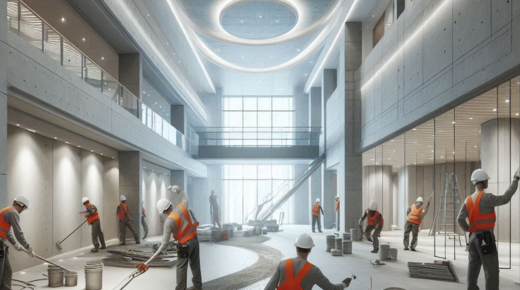When it comes to commercial construction and renovations, one of the most vital elements to consider is commercial drywall. This versatile building material plays a crucial role in defining spaces, providing insulation, and ensuring structural integrity. Whether you’re involved in new construction or remodeling existing spaces, understanding the nuances of drywall installation and related services is essential. In this article, we will explore various aspects of basement drywall, interior paint, drywall installation, and new construction drywall to help you make informed decisions for your projects.
What is Commercial Drywall?
Commercial drywall is a type of wallboard specifically designed for use in commercial buildings. It is made from gypsum plaster that is sandwiched between two thick sheets of paper. This material is known for its fire resistance, soundproofing qualities, and versatility, making it ideal for various commercial applications, including offices, retail spaces, and warehouses.
One of the standout features of commercial drywall is its ability to be customized according to the specific needs of a project. From moisture-resistant boards for high-humidity areas to impact-resistant options for high-traffic spaces, the right choice of drywall can enhance the durability and longevity of your interior walls.
Benefits of Commercial Drywall
- Cost-Effective: Compared to traditional wall materials like plaster, drywall is more affordable and quicker to install, making it a popular choice for commercial projects.
- Fire Resistance: Many types of commercial drywall are fire-rated, which helps to slow the spread of flames and provide crucial time for evacuation during a fire emergency.
- Soundproofing: Drywall can effectively reduce noise between rooms and create a more comfortable working environment, particularly in offices or conference rooms.
- Versatility: With various thicknesses and finishes available, commercial drywall can be tailored to meet the specific requirements of different spaces, whether for new construction or remodeling.
Installing Basement Drywall
One of the most critical areas in any commercial property is the basement. It often serves as storage, mechanical space, or even additional office areas. Installing basement drywall requires special considerations due to potential moisture and humidity issues.
Here are some tips for successful basement drywall installation:
- Choose the Right Type of Drywall: Use moisture-resistant drywall (also known as green board) in areas prone to dampness. This type of drywall is treated to resist mold and mildew, making it ideal for basements.
- Ensure Proper Framing: Install metal or treated wood studs that are specifically designed for damp environments. This helps to prevent warping and deterioration over time.
- Use Vapor Barriers: Apply a vapor barrier on the walls before installing drywall to further protect against moisture intrusion. This barrier will help keep the drywall dry and prevent mold growth.
- Ventilation: Ensure adequate ventilation in the basement to reduce humidity levels. This can involve installing exhaust fans or dehumidifiers to maintain optimal air quality.
Interior Paint: A Finishing Touch
Once the drywall installation is complete, it’s time to think about the finishing touches—specifically, interior paint. The right paint not only enhances the aesthetic appeal of the space but also provides additional protection for the walls.
Here are some factors to consider when selecting interior paint for your commercial property:
- Durability: Choose paints that are specifically designed for high-traffic areas. Look for options that are washable and resistant to stains and scuffs, ensuring your walls look fresh and new for longer.
- Color Psychology: Colors can significantly impact mood and productivity in commercial spaces. Consider using calming colors in offices and more vibrant hues in creative spaces to enhance employee morale and creativity.
- Finish Types: Select the appropriate finish for your needs. Matte finishes can hide imperfections, while semi-gloss and gloss finishes are more durable and easier to clean.
- Eco-Friendly Options: Consider using low-VOC (volatile organic compounds) paints to promote better indoor air quality, especially in commercial environments where people spend significant amounts of time.
Drywall Installation Tips
Successful drywall installation is crucial for ensuring a professional finish and long-lasting durability. Here are some best practices to follow:
- Preparation: Ensure that the framing is level and clean. This will help the drywall lie flat and avoid any future cracking or warping.
- Measurement and Cutting: Measure carefully and cut drywall sheets using a utility knife. Make sure to wear appropriate safety gear, such as goggles and gloves.
- Fastening: Use drywall screws instead of nails for a stronger hold. Ensure screws are set just below the surface without breaking the paper face.
- Taping and Finishing: Apply joint tape over seams and use a joint compound to fill in any gaps. This process requires multiple coats to achieve a smooth finish, so be patient and allow adequate drying time between applications.
- Sanding: Once the final coat of joint compound has dried, sand the surface to create a smooth finish before painting.
New Construction Drywall: A Key Component
In new construction drywall, it’s essential to select materials that align with the design and purpose of the building. Here are some considerations to keep in mind:
- Building Codes: Ensure that the drywall you choose meets local building codes and fire safety regulations.
- Energy Efficiency: Consider using insulated drywall or adding insulation behind the drywall to improve the energy efficiency of the building.
- Future-Proofing: Plan for future needs by installing flexible wall systems that can be easily modified for changing layouts.
- Professional Installation: Hiring experienced contractors for new construction drywall installation can save you time and money in the long run. They understand the intricacies of the installation process and can ensure a high-quality finish.
Conclusion
Whether you are involved in commercial drywall projects, basement drywall installations, choosing interior paint, or undertaking drywall installation for new construction drywall, understanding these elements can greatly enhance the quality and appeal of your spaces. With careful planning, the right materials, and attention to detail, you can create interiors that are not only functional but also visually appealing. Embrace the benefits of drywall in your next commercial project, and watch your spaces transform into stunning environments that serve both employees and clients effectively.

